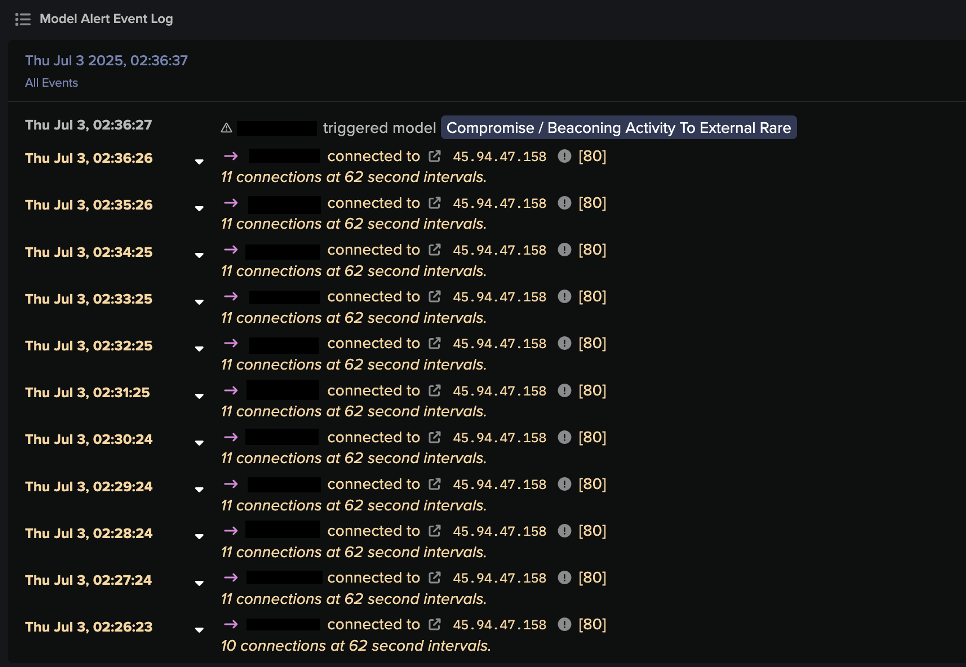Ivanti & Edge infrastructure exploitation
Edge infrastructure exploitations continue to prevail in today’s cyber threat landscape; therefore, it was no surprise that recent Ivanti Endpoint Manager Mobile (EPMM) vulnerabilities CVE-2025-4427 and CVE-2025-4428 were exploited targeting organizations in critical sectors such as healthcare, telecommunications, and finance across the globe, including across the Darktrace customer base in May 2025.
Exploiting these types of vulnerabilities remains a popular choice for threat actors seeking to enter an organization’s network to perform malicious activity such as cyber espionage, data exfiltration and ransomware detonation.
Vulnerabilities in Ivanti EPMM
Ivanti EPMM allows organizations to manage and configure enterprise mobile devices. On May 13, 2025, Ivanti published a security advisory [1] for their Ivanti Endpoint Manager Mobile (EPMM) devices addressing a medium and high severity vulnerability:
- CVE-2025-4427, CVSS: 5.6: An authentication bypass vulnerability
- CVE-2025-4428, CVSS: 7.2: Remote code execution vulnerability
Successfully exploiting both vulnerabilities at the same time could lead to unauthenticated remote code execution from an unauthenticated threat actor, which could allow them to control, manipulate, and compromise managed devices on a network [2].
Shortly after the disclosure of these vulnerabilities, external researchers uncovered evidence that they were being actively exploited in the wild and identified multiple indicators of compromise (IoCs) related to post-exploitation activities for these vulnerabilities [2] [3]. Research drew particular attention to the infrastructure utilized in ongoing exploitation activity, such as leveraging the two vulnerabilities to eventually deliver malware contained within ELF files from Amazon Web Services (AWS) S3 bucket endpoints and to deliver KrustyLoader malware for persistence. KrustyLoader is a Rust based malware that was discovered being downloaded in compromised Ivanti Connect Secure systems back in January 2024 when the zero-day critical vulnerabilities; CVE-2024-21887 and CVE-2023-46805 [10].
This suggests the involvement of the threat actor UNC5221, a suspected China-nexus espionage actor [3].
In addition to exploring the post-exploit tactics, techniques, and procedures (TTPs) observed for these vulnerabilities across Darktrace’s customer base, this blog will also examine the subtle changes and similarities in the exploitation of earlier Ivanti vulnerabilities—specifically Ivanti Connect Secure (CS) and Policy Secure (PS) vulnerabilities CVE-2023-46805 and CVE-2024-21887 in early 2024, as well as CVE-2025-0282 and CVE-2025-0283, which affected CS, PS, and Zero Trust Access (ZTA) in January 2025.
Darktrace Coverage
In May 2025, shortly after Ivanti disclosed vulnerabilities in their EPMM product, Darktrace’s Threat Research team identified attack patterns potentially linked to the exploitation of these vulnerabilities across multiple customer environments. The most noteworthy attack chain activity observed included exploit validation, payload delivery via AWS S3 bucket endpoints, subsequent delivery of script-based payloads, and connections to dpaste[.]com, possibly for dynamic payload retrieval. In a limited number of cases, connections were also made to an IP address associated with infrastructure linked to SAP NetWeaver vulnerability CVE-2025-31324, which has been investigated by Darktrace in an earlier case.
Exploit Validation
Darktrace observed devices within multiple customer environments making connections related to Out-of-Band Application Security Testing (OAST). These included a range of DNS requests and connections, most of which featured a user agent associated with the command-line tool cURL, directed toward associated endpoints. The hostnames of these endpoints consisted of a string of randomly generated characters followed by an OAST domain, such as 'oast[.]live', 'oast[.]pro', 'oast[.]fun', 'oast[.]site', 'oast[.]online', or 'oast[.]me'. OAST endpoints can be leveraged by malicious actors to trigger callbacks from targeted systems, such as for exploit validation. This activity, likely representing the initial phase of the attack chain observed across multiple environments, was also seen in the early stages of previous investigations into the exploitation of Ivanti vulnerabilities [4]. Darktrace also observed similar exploit validation activity during investigations conducted in January 2024 into the Ivanti CS vulnerabilities CVE-2023-46805 and CVE-2024-21887.
Payload Delivery via AWS
Devices across multiple customer environments were subsequently observed downloading malicious ELF files—often with randomly generated filenames such as 'NVGAoZDmEe'—from AWS S3 bucket endpoints like 's3[.]amazonaws[.]com'. These downloads occurred over HTTP connections, typically using wget or cURL user agents. Some of the ELF files were later identified to be KrustyLoader payloads using open-source intelligence (OSINT). External researchers have reported that the KrustyLoader malware is executed in cases of Ivanti EPMM exploitation to gain and maintain a foothold in target networks [2].
In one customer environment, after connections were made to the endpoint fconnect[.]s3[.]amazonaws[.]com, Darktrace observed the target system downloading the ELF file mnQDqysNrlg via the user agent Wget/1.14 (linux-gnu). Further investigation of the file’s SHA1 hash (1dec9191606f8fc86e4ae4fdf07f09822f8a94f2) linked it to the KrustyLoader malware [5]. In another customer environment, connections were instead made to tnegadge[.]s3[.]amazonaws[.]com using the same user agent, from which the ELF file “/dfuJ8t1uhG” was downloaded. This file was also linked to KrustyLoader through its SHA1 hash (c47abdb1651f9f6d96d34313872e68fb132f39f5) [6].
The pattern of activity observed so far closely mirrors previous exploits associated with the Ivanti vulnerabilities CVE-2023-46805 and CVE-2024-21887 [4]. As in those cases, Darktrace observed exploit validation using OAST domains and services, along with the use of AWS endpoints to deliver ELF file payloads. However, in this instance, the delivered payload was identified as KrustyLoader malware.
Later-stage script file payload delivery
In addition to the ELF file downloads, Darktrace also detected other file downloads across several customer environments, potentially representing the delivery of later-stage payloads.
The downloaded files included script files with the .sh extension, featuring randomly generated alphanumeric filenames. One such example is “4l4md4r.sh”, which was retrieved during a connection to the IP address 15.188.246[.]198 using a cURL-associated user agent. This IP address was also linked to infrastructure associated with the SAP NetWeaver remote code execution vulnerability CVE-2025-31324, which enables remote code execution on NetWeaver Visual Composer. External reporting has attributed this infrastructure to a China-nexus state actor [7][8][9].
In addition to the script file downloads, devices on some customer networks were also observed making connections to pastebin[.]com and dpaste[.]com, two sites commonly used to host or share malicious payloads or exploitation instructions [2]. Exploits, including those targeting Ivanti EPMM vulnerabilities, can dynamically fetch malicious commands from sites like dpaste[.]com, enabling threat actors to update payloads. Unlike the previously detailed activity, this behavior was not identified in any prior Darktrace investigations into Ivanti-related vulnerabilities, suggesting a potential shift in the tactics used in post-exploitation stages of Ivanti attacks.
Conclusion
Edge infrastructure vulnerabilities, such as those found in Ivanti EPMM and investigated across customer environments with Darktrace / NETWORK, have become a key tool in the arsenal of attackers in today’s threat landscape. As highlighted in this investigation, while many of the tactics employed by threat actors following successful exploitation of vulnerabilities remain the same, subtle shifts in their methods can also be seen.
These subtle and often overlooked changes enable threat actors to remain undetected within networks, highlighting the critical need for organizations to maintain continuous extended visibility, leverage anomaly based behavioral analysis, and deploy machine speed intervention across their environments.
Credit to Nahisha Nobregas (Senior Cyber Analyst) and Anna Gilbertson (Senior Cyber Analyst)
Appendices
Mid-High Confidence IoCs
(IoC – Type - Description)
- trkbucket.s3.amazonaws[.]com – Hostname – C2 endpoint
- trkbucket.s3.amazonaws[.]com/NVGAoZDmEe – URL – Payload
- tnegadge.s3.amazonaws[.]com – Hostname – C2 endpoint
- tnegadge.s3.amazonaws[.]com/dfuJ8t1uhG – URL – Payload
- c47abdb1651f9f6d96d34313872e68fb132f39f5 - SHA1 File Hash – Payload
- 4abfaeadcd5ab5f2c3acfac6454d1176 - MD5 File Hash - Payload
- fconnect.s3.amazonaws[.]com – Hostname – C2 endpoint
- fconnect.s3.amazonaws[.]com/mnQDqysNrlg – URL - Payload
- 15.188.246[.]198 – IP address – C2 endpoint
- 15.188.246[.]198/4l4md4r.sh?grep – URL – Payload
- 185.193.125[.]65 – IP address – C2 endpoint
- 185.193.125[.]65/c4qDsztEW6/TIGHT_UNIVERSITY – URL – C2 endpoint
- d8d6fe1a268374088fb6a5dc7e5cbb54 – MD5 File Hash – Payload
- 64.52.80[.]21 – IP address – C2 endpoint
- 0d8da2d1.digimg[.]store – Hostname – C2 endpoint
- 134.209.107[.]209 – IP address – C2 endpoint
Darktrace Model Detections
- Compromise / High Priority Tunnelling to Bin Services (Enhanced Monitoring Model)
- Compromise / Possible Tunnelling to Bin Services
- Anomalous Server Activity / New User Agent from Internet Facing System
- Compliance / Pastebin
- Device / Internet Facing Device with High Priority Alert
- Anomalous Connection / Callback on Web Facing Device
- Anomalous File / Script from Rare External Location
- Anomalous File / Incoming ELF File
- Device / Suspicious Domain
- Device / New User Agent
- Anomalous Connection / Multiple Connections to New External TCP Port
- Anomalous Connection / New User Agent to IP Without Hostname
- Anomalous File / EXE from Rare External Location
- Anomalous File / Internet Facing System File Download
- Anomalous File / Multiple EXE from Rare External Locations
- Compromise / Suspicious HTTP and Anomalous Activity
- Device / Attack and Recon Tools
- Device / Initial Attack Chain Activity
- Device / Large Number of Model Alerts
- Device / Large Number of Model Alerts from Critical Network Device
References
3. https://www.wiz.io/blog/ivanti-epmm-rce-vulnerability-chain-cve-2025-4427-cve-2025-4428
7. https://www.virustotal.com/gui/ip-address/15.188.246.198
The content provided in this blog is published by Darktrace for general informational purposes only and reflects our understanding of cybersecurity topics, trends, incidents, and developments at the time of publication. While we strive to ensure accuracy and relevance, the information is provided “as is” without any representations or warranties, express or implied. Darktrace makes no guarantees regarding the completeness, accuracy, reliability, or timeliness of any information presented and expressly disclaims all warranties.
Nothing in this blog constitutes legal, technical, or professional advice, and readers should consult qualified professionals before acting on any information contained herein.
Any references to third-party organizations, technologies, threat actors, or incidents are for informational purposes only and do not imply affiliation, endorsement, or recommendation.
Darktrace, its affiliates, employees, or agents shall not be held liable for any loss, damage, or harm arising from the use of or reliance on the information in this blog.
The cybersecurity landscape evolves rapidly, and blog content may become outdated or superseded. We reserve the right to update, modify, or remove any content without notice.












































![Autonomous Response’s suggested actions to block suspicious connectivity to IP 45.94.47[.]149 for the device within the second customer environment.](https://cdn.prod.website-files.com/626ff4d25aca2edf4325ff97/6931e3cb1ddc36af8205720b_Screenshot%202025-12-04%20at%2011.40.54%E2%80%AFAM.png)

![Cyber AI Analyst investigation finding a successful POST request to 45.94.47[.]144 for the device within the third customer environment.](https://cdn.prod.website-files.com/626ff4d25aca2edf4325ff97/6931e41d22eb7e9a3e8217d5_Screenshot%202025-12-04%20at%2011.42.15%E2%80%AFAM.png)

